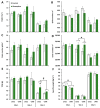Glutacetine® Biostimulant Applied on Wheat under Contrasting Field Conditions Improves Grain Number Leading to Better Yield, Upgrades N-Related Traits and Changes Grain Ionome
- PMID: 33670931
- PMCID: PMC7997451
- DOI: 10.3390/plants10030456
Glutacetine® Biostimulant Applied on Wheat under Contrasting Field Conditions Improves Grain Number Leading to Better Yield, Upgrades N-Related Traits and Changes Grain Ionome
Abstract
Wheat is one of the most important cereals for human nutrition, but nitrogen (N) losses during its cultivation cause economic problems and environmental risks. In order to improve N use efficiency (NUE), biostimulants are increasingly used. The present study aimed to evaluate the effects of Glutacetine®, a biostimulant sprayed at 5 L ha-1 in combination with fertilizers (urea or urea ammonium nitrate (UAN)), on N-related traits, grain yield components, and the grain quality of winter bread wheat grown at three field sites in Normandy (France). Glutacetine® improved grain yield via a significant increase in the grain number per spike and per m2, which also enhanced the thousand grain weight, especially with urea. The total N in grains and the NUE tended to increase in response to Glutacetine®, irrespective of the site or the form of N fertilizer. Depending on the site, spraying Glutacetine® can also induce changes in the grain ionome (analyzed by X-ray fluorescence), with a reduction in P content observed (site 2 under urea nutrition) or an increase in Mn content (site 3 under UAN nutrition). These results provide a roadmap for utilizing Glutacetine® biostimulant to enhance wheat production and flour quality in a temperate climate.
Keywords: SPAD-502®; Triticum aestivum; X-ray fluorescence; grain quality; ionome; nitrogen fertilizer; nitrogen use efficiency; plant biostimulants.
Conflict of interest statement
Authors Victor Maignan and Patrick Géliot were employed by the company Via Végétale. The remaining authors declare that the research was conducted in the absence of any commercial or financial relationships that could be construed as a potential conflict of interest. The funders had no role in the design of the study; in the collection, analyses, or interpretation of data; in the writing of the manuscript, or in the decision to publish the results.
Figures



Similar articles
-
Biostimulant impacts of Glutacetine® and derived formulations (VNT1 and VNT4) on the bread wheat grain proteome.J Proteomics. 2021 Jul 30;244:104265. doi: 10.1016/j.jprot.2021.104265. Epub 2021 May 13. J Proteomics. 2021. PMID: 33992839
-
Biostimulant Effects of Glutacetine® and Its Derived Formulations Mixed With N Fertilizer on Post-heading N Uptake and Remobilization, Seed Yield, and Grain Quality in Winter Wheat.Front Plant Sci. 2020 Nov 13;11:607615. doi: 10.3389/fpls.2020.607615. eCollection 2020. Front Plant Sci. 2020. PMID: 33281859 Free PMC article.
-
Micro-irrigation improves grain yield and resource use efficiency by co-locating the roots and N-fertilizer distribution of winter wheat in the North China Plain.Sci Total Environ. 2018 Dec 1;643:367-377. doi: 10.1016/j.scitotenv.2018.06.157. Epub 2018 Jun 22. Sci Total Environ. 2018. PMID: 29940448
-
Analysing nitrogen responses of cereals to prioritize routes to the improvement of nitrogen use efficiency.J Exp Bot. 2009;60(7):1939-51. doi: 10.1093/jxb/erp116. Epub 2009 Apr 23. J Exp Bot. 2009. PMID: 19395389 Review.
-
Genetic variation in traits for nitrogen use efficiency in wheat.J Exp Bot. 2017 May 1;68(10):2627-2632. doi: 10.1093/jxb/erx079. J Exp Bot. 2017. PMID: 28338945 Review.
Cited by
-
Effect of biostimulants combined with fertilization on yield and nutritional value of wheat crops.BMC Plant Biol. 2025 May 31;25(1):736. doi: 10.1186/s12870-025-06804-3. BMC Plant Biol. 2025. PMID: 40450219 Free PMC article.
References
-
- Lassaletta L., Billen G., Grizzetti B., Anglade J., Garnier J. 50 year trends in nitrogen use efficiency of world cropping systems: The relationship between yield and nitrogen input to cropland. Environ. Res. Lett. 2014;9:105011. doi: 10.1088/1748-9326/9/10/105011. - DOI
Grants and funding
LinkOut - more resources
Full Text Sources
Other Literature Sources
Research Materials

